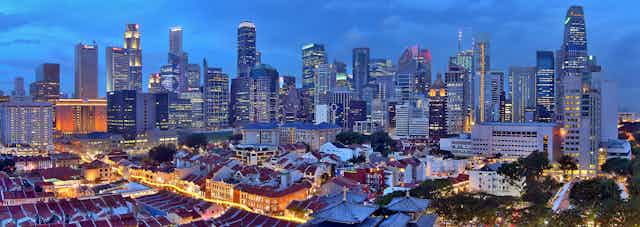Ten themes shape the dilemmas, challenges and opportunities for the 21st-century city. Each relates to how we live and shape our places.
The tradition of urban living, of urbanity, focuses both on the rights of its inhabitants to the city, and the responsibility they bear for the city. Urbanity in this sense first arose in the Italian city states, notably during the Renaissance. It marked the move towards meritocracy, providing a space for free thinking and freeing individuals from the yoke of feudalism. The German phrase Stadtluft macht frei (“city air makes you free”) encapsulates this idea. But over time the notion of urbanity degraded into the idea of the flâneur, someone who watches urban life go by without committing to the needs of the collective whole.
Together, ten interlinked concepts frame our modern idea of civic urbanity, and can be used to reshape how we see and shape cities for the future. Using these we can seek to realign individual self-interest within a collective consciousness that is focused more on our joint responsibilities for our city, or indeed our world.
The starting point is integrated and connected thinking. Only then can we discern the links and inter-dependencies in the city dynamic, and how to make the most of their potential. This requires a changed mindset and is difficult to prescribe. Even so, governments and decision-makers have increasingly realised the shortcomings of strict departmentalism and silo thinking that stymie the creative solutions required.
There is a demand for a reinvigorated public and shared commons to stand against, but also to complement, an increasingly self-centred public culture. It should foster shared spaces, from parks to public libraries, that are free, non-commercial, and public, where citizens can express themselves in creative ways. With this ethos we can retrofit our cities with conviviality and the habits of solidarity, in order to nurture our capacity to build communities.
Planners these days discuss sustainability and the effects of climate change, and there are many good initiatives worldwide. Yet few city planners make the hard choices to prevent the customary configurations of cities or developments that continue to make them unsustainable. Embedding a sense of eco-awareness in a city means building introducing zero-waste, cyclical economies and smart technologies. This can be a lever for economic development towards a clean, lean, green industrial revolution.
We must avoid unhealthy urban planning – rigid land-use zoning that prevents the sort of mixed-use developments that blend living, working, retail and entertainment, big initiatives that fail to provide diversity and variety, or the tendency to think that, through economies of scale, only big can be efficient. And believing in the inevitability of the car leads to cities designed for vehicles, not people. Mixed uses are coming back forcefully as living, working and playing in the same place becomes the norm again. Seamless transport connectivity, or walkable cities, will be key.
Many cities are ethnic and cultural melting pots, boosting economic growth long-term – but absorbing differences will continue to create stresses. Cultural literacy, an understanding of others and focusing on what we share, rather than what divides us, will be key – as will avoiding housing ghettos and gated communities. But market pressures will continue to push cities in the wrong direction.
Magnetic cities, those that everyone wants to move to, are increasingly unequal. The divide between rich and poor grows, creating tension, resentment, unfulfilled potential – and even violence. Any city where haves and have-nots are strictly divided has failed to harness the collective imagination, energy and intelligence of its citizens. Clever cities will demand greater equality and inclusiveness, because it makes social and economic sense.
The demographic time-bomb hangs over us all, but in cities especially there will be pressure to isolate the ageing population into “retirement zones” with housing adapted to their needs. More innovative cities will seek to incorporate an inter-generational perspective to their planning and develop adaptable housing that can be transformed as its inhabitants age.
The aesthetic imperative reminds us that the city is an immersive experience that communicates through its structures, its natural forms, its activities, and atmosphere. The way a city looks and feels, its aesthetics, create an emotional response and a psychological impact. Old-fashioned words like beauty and ugliness will – should – re-enter the planning debate.
The escalating complexities that cities face cannot be solved by a “business-as-usual” approach. Imagination and creativity are required to solve intractable urban problems of the future and create new and interesting opportunities. Unleashing the creativity of the city, its organisations and citizens is an empowering process, harnessing potential and is a new form of capital and currency.
This reminds us: technology has moved in gigantic leaps, but our forms of representative democracy, organisation and management have remained largely the same for hundreds of years. This is why civic engagement has atrophied. Future cities will need to reignite the civic spirit by exploring new ways of communicating with citizens, rethinking regulations and incentives and empowering civil servants. This requires a new type of administration, a creative bureaucracy, radically different from the target-driven, efficiency and effectiveness-focused model. Being resourceful, strategically agile, responsive and imaginative will lie at its core.

